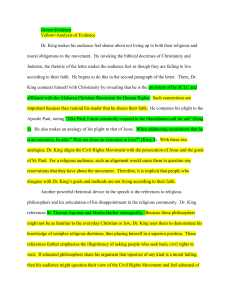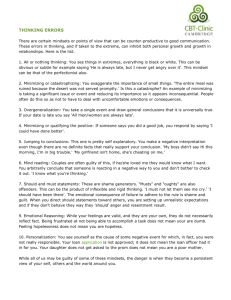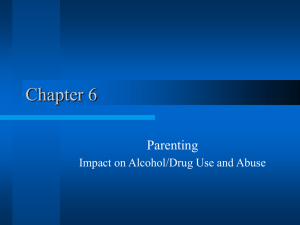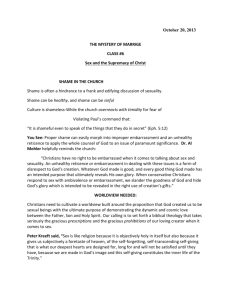Towards A Deep Cultural Psychology of Shame
advertisement
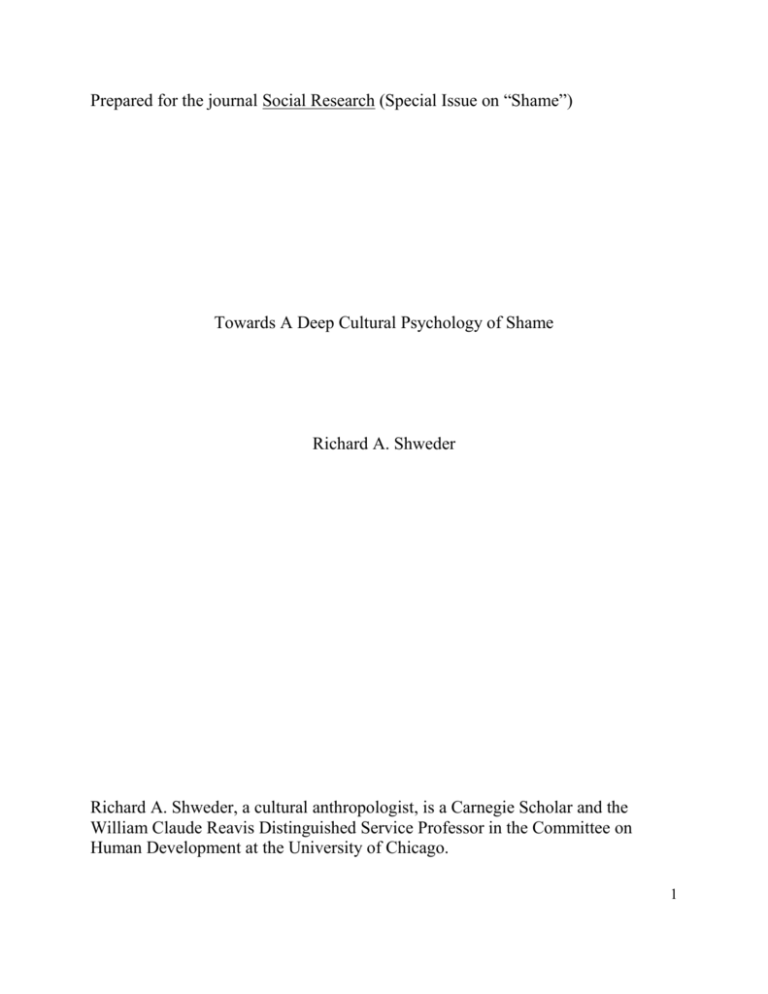
Prepared for the journal Social Research (Special Issue on “Shame”) Towards A Deep Cultural Psychology of Shame Richard A. Shweder Richard A. Shweder, a cultural anthropologist, is a Carnegie Scholar and the William Claude Reavis Distinguished Service Professor in the Committee on Human Development at the University of Chicago. 1 “When it comes to the meaning of the emotions ‘shame’ is ‘shame’, whether it is experienced on the East Coast of India or on the Upper West Side of Manhattan, by a man or by a woman, in 2004 or in 1789.” That proposition that “shame is shame wherever you go” may seem self-evidently true; nevertheless it is a rather disappointing conclusion, if you are an anthropologist or cultural psychologist interested in the way human mental states differ across cultural groups. It is a conclusion I plan to contest, or at least qualify, in this essay. When it comes to the study of the meaning of emotions, such as “shame”, what does cultural psychology have to contribute, if anything? Can one hope for more than just a frequency count account of cross-cultural variations in emotional functioning, something a bit more “meaning-centered” than “there’s lots of shame in the East, less in the West”. In this essay I try to describe what a deep cultural psychology of “shame” might look like. Shame is Shame: The Analytic Appeal. Imagine some American anthropologist who returns home after years of field research and reports the following: “Among the Oriya language speaking Brahman families I studied in a Hindu temple town in India ‘shame’ does not have the same meaning that it has in our culture. For those Brahman families ‘shame’ is the good feeling people have when they manage to acquire the things they most want in life and their acquisitive success is displayed to other members of their community. The word for ‘shame’ in the Oriya language is ‘lajya’ (or ‘lajja’)”. I think I know how I would react to such a research report. I would probably find the first sentence quite appealing, because, as a fellow anthropologist interested in the study of the cultural psychology of other peoples and of mental differences across groups, I would be theoretically open to the possibility of cross-cultural variations in what members of different cultural communities know, want, value and feel, which would suggest to me that there might be cross-cultural variations in the “emotions” as well (see for example, Briggs 1970; Geertz 1993; Goddard 1997; Kitayama and Markus 1994; Kleinman and Good 1985; Lutz 1988; Lutz and White 1986; Markus, Kitayama and Heiman 1998; Mesquita and Frijda 1992; Parish 1991; Rosaldo 1984; Rozin, Haidt and MacCauley 1999; Russell 1991; Schieffelin 1985; Shweder 1991, 1993, 1994, 2003a, 2003b; Shweder and Haidt 1999; Wierzbicka 1990, 1999). Reading on, however, I would surely feel disappointed. The sentence in the research report where we are told what “shame” really means to Oriya Brahmans 2 would strike me as (either) confused, unintelligible, incomplete or perhaps incoherent. I would think to myself: One does not have to travel to South Asia to understand that acquiring the things you most want in life, advertising your success, and feeling good about it, are not recognizable components of, or expressions of, the abstract idea or concept of shame. With much regret, I would have to conclude that the adduced definition of Oriya Brahman “shame” is not a specification of a shame-like mental state at all, and therefore could not possibly be comprehended as a culturally distinct elaboration of the idea of “shame.” I would wonder whether the anthropologist might have confused a particular type of action (the public display of good feelings about personal success) which might be judged to be shameful by Oriya Brahmans with the meaning of the idea of shame itself. I might recall my own first trip to India, when I met an Oriya Brahman who had seen the movie “My Fair Lady” and who expressed his loathing and horror at what he took to be the dishonorable way Professor Henry Higgins – singing “we did it, we did it” to Colonel Pickering, his male co-conspirator - had gloated over, and trumpeted, his success at training the working class Liza Doolittle to pass as a well-spoken aristocrat. The Brahman thought that such a self-congratulatory display of pride revealed a defect of English character, and was shameless, but he did not think that the concept of shame could be defined as “a self-congratulatory display of good feeling”). Thus, I would feel disappointed that the anthropologist had not drawn some distinctions, of the sort that are now pretty standard among researchers who study the emotions from a “symbolic”, “cognitive appraisal” or “meaning-centered” point of view (Ellsworth 1991; Frijda 1986; Lazarus 1991; Mesquita and Frijda 1992; Russell 1991; Scherer, Walbott and Summerfield 1986; Shweder and Haidt 1999), so as to be able to decompose a complex emotional mental state such as “shame” (itself a mix of feelings, wants, values and beliefs) into various components. For analytic purposes and for the sake of making judgments about similarities and differences (or equivalence) between emotion-like mental states across cultures it can be helpful to separate out the following components of a complete emotional episode: 1. Situational determinants: Here one asks whether members of different cultural groups are alike or different in the antecedent conditions of the world (e.g., a public display of success, exposure of the sexual parts of the body) that elicit a particular emotional response. 3 2. Self-Appraisal features: Here one asks whether members of different cultural groups are alike or different in the perceived implications of the emotional response for their personal identity, agency, social standing and self-regard (e.g., status loss, goalblockage). 3. Somatic phenomenology: Here one asks whether members of different cultural groups are alike or different in their particular bodily feelings (e.g., muscle tension, shortness of breath) when experiencing the particular emotional state. These are physically localized feelings of the body. 4. Affective phenomenology: Here one asks whether members of different cultural groups are alike or different in their affective feelings (e.g., feelings of emptiness, agitation, contractedness) when experiencing the emotional state. These are existential feelings of the self or the “soul”. 5. Social appraisal: Here one asks whether members of different cultural groups are alike or different in the extent to which displaying one’s emotional state has been socially baptized a vice or virtue, a sign of sickness or health, a signal of deviance or normalcy. 6. Self-management: Here one asks whether members of different cultural groups are alike or different in the plans for self-management (e.g., to withdraw, to hide, to apologize, to confess) that are activated as part of an action routine to cope with somatic and affective feelings and with the self-appraisals that are associated with the emotional state. 7. Communication: Here one asks whether members of different cultural groups are alike or different in their iconic or symbolic vehicles (e.g., facial expressions, voice quality, posture, selfdescriptions) for expressing the whole package of interconnected episodic components (1-6 above)? In the light of those distinctions, when our hypothetical American anthropologist proposes that “shame” does not have the same meaning for Oriya Brahmans that it 4 has in “our culture” it is unclear whether his or her focus is on one particular situational determinant (a public display of personal success, which is not really part of the meaning of the emotional state itself, but rather a condition of its elicitation) or whether the focus is on the self-appraisal condition (in which case the proposal seems unintelligible). The concept of shame is rich in implications for ones sense of self, self-regard and personal identity, but it does not mean feeling good about, and publicly displaying, your acquisitive success. Indeed, the very lack of intelligibility of the anthropologist’s claim - that in some far away place shame means something it could not possibly mean - would inevitably have lead me to reiterate the hermeneutic principle that the abstract idea of shame (whatever its form, identity, essence or definition might be) is what it is, means what it means and therefore must convey at least that minimal meaning wherever you happen to be on the globe when you make use of the concept of shame to describe the condition of someone’s mental life. To that extent the analytic principle that “shame is shame” is self-evident, and thus has a powerful appeal. If Shame is Shame What Is Its Abstract Form or Minimal Mandatory Meaning? What mandatory or minimal meaning does the idea of shame require, whenever and wherever you use it to describe someone’s state of mind? Or, alternatively put, is there an abstract form to “shame”? Let’s consider a few conceptions of shame proposed by thoughtful authors. Shame, writes Janna Malamud Smith (1997), in her gorgeous book about the many faces of privacy, is “the wish to remain lovable, and the fear that if truly known, one will be found lacking.” Shame, write Gerhart Piers and Milton Singer (1971), in their famous critique of the claim that one can classify cultures as “shame cultures” or “guilt cultures”, is a sense of failure caused by the recognition of a discrepancy between the ego and the ego ideal. Shame, writes Roger Scruton (1986:141), in his provocative philosophical treatise on the subject of sexual desire, is a special kind of embarrassment, which gives expression to a very particular kind of fear, namely, the fear that one “runs the risk of another’s contempt, indignation, disapproval or other negative assessment.” (1986:141). A person feels shame, according to his account, when they are made to feel degraded, dirty or impure by the attention of others, which can happen in many ways. 5 Sigmund Freud links shame (and blushing) to the thought of, or desire for, a forbidden pleasure; while Havelock Ellis defines it as the fear of being disgusting to others, which he believes motivates the universal practice of covering those (presumed to be disgusting) sexual parts of the body that are located below the waist (see Scruton 1986: 142). In direct contrast to the views of Freud and Ellis, Scruton argues that “the occasion of shame [e.g., when a woman feels defiled by a prurient male glance] is neither the thought of ‘forbidden pleasure’ nor the exposure of the sexual parts of the body.” Shame, he suggests, is the embarrassment produced by a rather different kind of exposure; namely, in this instance (of being made to blush by someone’s prurient glance), by an exposure, both unwanted and unbidden, “to the desirous thoughts of another who is not desired, and who compels, through his interest, the degrading perception of oneself as partner to an obscenity.” (Scruton, 1986: 145; for additional views on "shame" see Fung, 1999; Haidt, 2003; Lewis, 1971; Lewis, 1992; Tangney and Fischer, 1995) If one tries to summarize or synthesize these various views so as to form an abstract idea of shame or (what amounts to the same thing) so as to describe the underlying concept that sets a mandatory limit on all conceivable definitions of shame, one might say that shame is the deeply felt and highly motivating experience of the fear of being judged defective. It is the anxious experience of either the real or anticipated loss of status, affection or self-regard that results from knowing that one is vulnerable to the disapproving gaze or negative judgment of others. It is a terror that touches the mind, the body and the soul precisely because one is aware that one might be seen to have come up short in relationship to some shared and uncontested ideal that defines what it means to be a good, worthy, admirable, attractive or competent person, given ones status or position in society. Having been made to become self-conscious and frightened in this way (perhaps in the light of a loss of privacy or due to an end to secrecy or even by means of selfexamination) one can run, cover up or withdraw (seeking escape or safety through invisibility) but one can’t really hide from the feeling of shame or the fear that “one will be found lacking.” The human blush or reddening of the face, whether voluntarily or involuntarily produced, might be thought of as a well-recognized sign of such vulnerability, and as a non-verbal appeal to others for sympathy, forgiveness or a mitigation of judgment. Such bashfulness can be appealing, in part because to blush at the exposure of ones own personal failure or impropriety is to accept and to honor the very virtues, high standards and ideals that were the cause of ones loss of face. Chivalrous men don’t try to make virtuous women 6 blush yet they admire them when they do; for their bashfulness does them honor, signaling, from inside to out, their commitment to uphold the social order and their desire do what is right. And, as we shall see, it is not just women who blush. Considered as an abstract idea (as the deeply felt and highly motivating experience of the fear of being judged defective), the concept of shame sets a mandatory limit on all conceivable (and potentially various) more substantive, full-bodied or culture-specific definitions of shame. That is the major part of its appeal; and that is why the anthropologist’s report about the culture-specific meaning of shame among Oriya Brahmans in India seems confused, unintelligible, incomplete or incoherent? Nevertheless I think one should be very cautious not to let that very legitimate Platonic thought take us too far down the primrose path to the seductive conclusion that the meaning of the emotions must be the same wherever you go. Down that primrose path one can well imagine some variety of rationalist saying: “Well, yes, of course, an anthropologist or cultural psychologist might actually have to do some systematic fieldwork and observational sampling in India to figure out how frequently Oriya Brahmans actually experience shame or to discover the particular types of occasions that lead men and women in a Hindu temple town to feel that way. But when it comes to the meaning of the emotions ‘shame’ is ‘shame’, whether it is experienced on the East Coast of India or on the Upper West Side of Manhattan, by a man or by a woman, in 2004 or in 1789.” What is a proper response to this hypothetical rationalist, who believes that our shame must be their shame, because our shame and their shame are shame, and shame is shame? For one thing, it seems to me quite reasonable to proclaim that within the broad limits set by the abstract concept of shame (the idea of a deeply felt and highly motivating experience of the fear of being judged defective) shamelike feelings of one sort or another are probably found everywhere in the world, at least among “normal” or non-psychopathic members of human social groups. One also does not want to deny that frequency counts are important in representing the cultural psychology of a cultural community. Cultural communities differ in their ideas about what is good, true, beautiful and efficient and in the customary social, political, economic and family life practices (the “way of life”) that they value and endorse because of those ideas. Different ways of life and different ways of thinking about the world may well occasion greater or fewer opportunities (what some psychologists call “affordances”) to experience some culture-specific 7 manifestation or variety of a mental state such as “shame”. To date there has been all too little research in cultural psychology sampling real world mental states across cultural communities. Nevertheless, it is not whether to count that’s the issue, but rather what to count; a deep investigation in cultural psychology must start by figuring out which mental states should be sampled and how they are to be recognized and described. Above all, it should be pointed out to the rationalist that a cultural psychology of shame – a meaning-centered account of the way shame differs across cultural groups - is possible because Immanuel Kant’s reciprocal rationalist dicta hold true. It is precisely because [concrete] percepts without [abstract] concepts are blind (dictum# 1) that the formal definition or abstract concept of shame is indeed a necessary or indispensable guide to our understanding of human mentalities. That abstract concept (the idea of a deeply felt and highly motivating experience of the fear of being judged defective) does set a mandatory limit on all conceivable (and potentially various) more substantive, full-bodied or culture-specific definitions of shame. Nevertheless, it is also precisely because [abstract] concepts without [concrete] percepts are empty (dictum# 2) that the abstract idea of shame leaves plenty of room for the concrete and contingent work of culture and history to give distinctive character, substance and meaning to the fear of being judged defective or of coming up short. Summing up, the proper response to the rationalist might be this: whatever the frequency with which particular mental states are experienced they are always experienced as culture-specific manifestations, and thus one fails to sufficiently understand the psychology of another cultural group if, on the basis of the assumption that shame is shame wherever you go, their local mental realization of the abstract idea of shame is treated as equivalent to ones own. A response of this sort appeals to at least two hermeneutic principles: (1) That it is possible for the same concept or abstract idea to acquire additional meanings across time and space; and (2) That when a concept or abstract idea becomes transformed into a mental state it unavoidably and inevitably acquires a series of local meanings that give it special character and individuate it as a distinctive state of mind. Shame: Universal Abstract Definitions and Culture-Specific Meanings. Consider, for example, Janna Malamud Smith’s sentimental individualistic conception (1997, see above), in which it is the wish to remain loveable that motivates the fear of being judged defective. Does she not thereby describe a 8 significant (and significance-laden) culture-specific (middle class, American) transformation of the mentality of shame? Other transformations, other ways of giving definition and adding character to the abstract idea of shame, are surely imaginable. Consider a second example, the conception of shame held by someone like Commander Lieutenant William Bligh, an officer in the status conscious 18th century British navy and the Captain of the famous ship the Bounty. Bligh lived at a transitional moment in cultural history and his conception of shame might have seemed antique in some social, political and literary circles in England even during his era. Quite notably, being loveable and happy were not primary life goals in his local world; sacrifice, the endurance of hardship in the service of doing your duty and the pursuit of exemplary revenge were highly prized. Prized as well were the public display and the clear and explicit acknowledgement of relative rank, status and privilege within the hierarchical ordering of the received stations of life. Thus, Bligh would have conceptualized shame as a fear of being judged defective in the in the light of the responsibilities, obligations and burdens of ones military or social position, which is a somewhat different conception of shame. In her recent masterful recounting, and critical re-evaluation, of the well-known legend of Fletcher Christian’s mutiny on the Bounty (Bligh it turns out was not a tyrant, and was in many ways a most admirable naval officer) the historian Caroline Alexander writes as follows: “It was Lieutenant Bligh’s ill luck to have his own great adventure coincide exactly with the dawn of this new era, which saw devotion to a code of duty and established authority as less honorable than the celebration of individual liberty and passion.” (Alexander 2003:345) Master’s Mate Fletcher Christian, it would seem, just wanted to stay in Tahiti where, to be sure, he was free to be loveable. “Sir, your abuse is so bad that I cannot do my duty with any pleasure”, he is reported to have complained to Captain Bligh shortly before the famous (or, as Alexander now suggests, infamous) mutiny on the morning of April 28, 1789 (see Alexander 2003). Bligh did not respond “I am so sorry you are not happy, for we really love you here”; he thought Christian’s behavior was outrageous and shameful, and that he was insubordinate, dishonorable, ungrateful, and out of his mind. Europe, of course, was in turmoil in the late 18th century and status structures of various kinds were being reexamined and overturned. Alexander (2003:328), who deftly unravels and debunks the legend of Fletcher Christian as the modern romantic sentimental liberationist hero sees the true story this way: “Into this 9 [historical] atmosphere of radical sympathizers [of the French Revolution] and ardent abolitionists [including English Romantics] was now flung the saga of the Bounty – a [fabricated] story of a young gentleman who, agonized by unprovoked and incessant abuse and disgrace, stood up for his natural rights and overthrew the oppressive tyrant who was his captain. Bucking the despised authority, he sailed away to freedom in the South Pacific.” Comparing those two specific conceptions of shame, notice that the abstract idea of the fear of being judged defective is common to the cultural and historical worlds of both Smith and Bligh yet there is still a world of difference between the “please love me” shame consciousness of Janna Malamud Smith and the “do you duty, that above all else” shame consciousness of William Bligh. How are the many different cultural worlds of shame to be described and accounted for? If the abstract idea of shame leaves plenty of space for the concrete and contingent work of culture and history to give it distinctive character, substance and meaning what constrains the way the space gets filled in? In the remainder of this essay I discuss one type of constraint on the meaning of shame. Socially shared and valued ego ideals, notions about a well-developed self, and ideas about what it means to be a good, worthy, admirable, attractive or competent person are variable across time and space; and as they vary the character, substance and meaning of “shame” can be expected to vary as well, although not in an unlimited number of ways. A more detailed discussion of the limited number of ways valued ego ideals (including preferred moral goods) and notions of a well-developed self constrain the meaning of emotions can be found in Shweder and Haidt (1999), including a discussion of “lajya”. A framework is described that has proved useful in recent cultural psychological work (Haidt, Koller and Dias 1993; Jensen, 1995; Menon and Shweder 1998; Shweder 1990; Shweder, Much, Mahapatra and Park 1997). Moral goods (e.g., justice, loyalty, sacrifice, liberty, sanctity) are related to culturally valued aspects of the self and do not vary randomly from culture to culture, but rather tend to cluster into three sets of related goods or three ethics, known as the ethics of autonomy, the ethics of community and the ethics of divinity. Presupposed by the "ethics of autonomy" is a conceptualization of the self as an individual preference structure, where the point of moral regulation is to increase choice and personal liberty. Presupposed by the "ethic of community" is a conceptualization of the self as an office holder. The basic idea is that one's role or station in life is intrinsic to ones identity and is part of a larger interdependent collective enterprise with a history and standing of its own. Presupposed by the 10 "ethics of divinity" is a conceptualization of the self as a spiritual entity connected to some sacred or natural order of things and as a responsible bearer of a legacy that is elevated and divine. Those who regulate their life within the terms of an "ethics of divinity" do not want to do anything, such as eating the flesh of a slaughtered animal, that is incommensurate with the nature of the spirit that joins the self to the divine ground of all things. Cultures rely upon the three ethics to varying degrees. The relative weights of the three ethics within a culture affect the experience and expression of emotion, as well as the way emotions are given meaning. It is suggested in Shweder and Haidt (1999; also see Shweder 1990; Shweder, Mahapatra and Miller 1986; Shweder, Much, Mahapatra and Park 1997) that in many parts of the world the moral domain has been constructed in such a way that it is broader than, or at least different from, an ethics of autonomy as it has been elaborated and privileged in the secular liberal middle class sectors of the contemporary United States. In cultures or sub-cultures that emphasize an ethics of community (the world of William Bligh or of an Oriya Brahman) priority is given to corporate or collective entities (for example, the family, the caste, the ship, the Navy) and the central moral goods are those that protect these entities against challenges from without and decay from within (e.g., goods such as loyalty, duty, honor, respectfulness, sacrifice, and self-control). Consider, for example, the meaning of “lajya” in the world of Oriya Brahmans. So What Is Lajya? A revealing and extraordinary representation of “lajya” can be found in a 15 th Century heroic Oriya story called the “Chandi Purana” (see Menon and Shweder 2003, for a fuller account), which is widely read even today. The story is authored by Sarala Dasa, a famous Oriya devotee of the Great Goddess of Hinduism (the Great Goddess is variously named, depending upon her guise, Devi, Parvati, Durga, Laxmi, Kali, Chandi, Chamundi, Saraswati, etc.). Sarala Dasa’s story is an epic description of the history of her battle with the great buffalo demon Mahisasura, who once terrorized the male gods and almost succeeded at taking over the world. Mahisasura’s quest for total power begins innocently enough. After 80,000 years of penance he has prevailed upon the male Gods in heaven to grant him a boon. He requests that he “shall not die at the hands of any man”. To which the Gods 11 respond: “So be it. Let all you desire come true. But remember, no one born in this world can remain immortal forever, no not even the Gods! For they must also die one day, Mark my words, you too shall die, and you shall die at the hands of a woman.” To which the demon retorts: “If that be so grant me another boon. That I shall not die at the hands of a woman Till I have beheld her naked breasts, her bare genitals.” The demon has now guaranteed that no male can kill him, and if one day he must die at the hands of a woman, he will have his last prurient glance at her naked body. Having quite stupidly granted the demon his wish, the gods, all males, are now entirely vulnerable to Mahisasura’s designs. They can’t stop him and he proceeds to take over the heavens. The Great Goddess is created as a last resort and brought forth to do battle with the buffalo demon. But none of the Gods have the courage to tell her about the details of the boon, namely, that Mahisasura can only by killed by a naked women. Deceived in this way and exhausted from endless and fruitless conflicts with the demon and his armies the Great Goddess finally learns of the boon from a female source. She then does what has to be done to save the world. She strips naked, exposes her genitals to the demon’s eyes, and then kills him on the spot. The following crucial subsequent scene is described in Sarala Dasa’s Chandi Purana. “The gods in heaven were overjoyed and decided to go to Durga [the Great Goddess] with offerings in their hands. They wanted to propitiate Devi. In humility and joy, they came to the mountain at Ratnagiri, bedecked in colorful clothes, with their armies, bearing precious metals. And there they beheld Devi, lying and resting, naked, without any clothes. Overcome with “lajya”, they could not draw near her. Seeing the gods, Mahadevi [the Great Goddess] exclaimed in rage: “There shall be no male gods left in heaven, none shall remain unslain today! You give the demons such boons that they destroy the three worlds! Would I have had to disrobe myself if there had not been such gods in heaven?” The gods then flee, in fear, all but one, Siva, the goddess’ future husband, who must now find some way to diminish the Goddess’ rage at the stupid and untrustworthy Gods, who failed to live up to their obligation to protect the “three worlds” and were deceitfully responsible for her humiliation. 12 There is another well-known version of the story, frequently narrated in Oriya households today in the context of explicating the meaning of a famous icon of the ten armed Kali, armed to the teeth, tongue out, and covered with symbols of death and destruction (see Menon and Shweder 1994). In that version it is the Great Goddess who is overcome with “lajya”. Enraged at having to expose the sexual parts of her body to the demon in order to save the world she decides that the world does not deserve to be saved and, in the form of Kali, goes on a mad rampage of destruction, killing and wrecking everything in sight. Siva, who in this version of the story is already her husband, lies supine on some road, anticipating her arrival. She is beside herself with rage and does not notice him, and accidentally steps on his chest. Looking down she sees what she has done [stepping on your husband is an act of great disrespect], bites her tongue, and is overcome with “lajya”. Her “lajya” leads her to regain her composure, cool out her anger, and transform herself back into a protective rather than destructive force. In both of these famous stories divine figures are overcome with “layja”. But what is “lajya”? And is it a culture-specific manifestation of the abstract idea of the fear of being judged defective? My own first encounter with Oriya “lajya” was in a less heroic context. In the summer of 1968 I began visiting the Hindu temple town of Bhubaneswar in the state of Orissa, India, where I have been conducting research, on and off, ever since (see, for example, Shweder, Mahapatra and Miller 1986; Shweder 1991, 2003b). Much of the research has focused on aspects of Oriya cultural mentality (what local people want, know, feel, and value as good or bad, right or wrong) with special reference to Oriya Brahmans and other caste communities in the temple town. During one of my field trips, many years ago, a bi-lingual Oriya friend of mine recommended a local young woman for a job as a research assistant, saying to me, in English, “She is a very shy girl. You should hire her”. I immediately realized, of course, that some kind of cross-cultural misunderstanding was unfolding before my eyes, and I was able to determine that my friend was trying to translate into English the Oriya word “lajya”. (He was also rendering in his mind the Oriya word for an unmarried female, which he mistranslated as “girl”. As it turned out she was 28 years old; his spontaneous translation from Oriya to English had failed to match my dialect in at least two 13 ways. In my dialect she was a “young unmarried woman with ‘lajya’, but I still did not know why he was recommending her to me in such terms, or what the Oriya word “lajya” meant). If you ask bi-lingual Oriya to English speakers to translate “lajya” into English they are likely to select English words such as “shame”, “shy”, “modest” “embarrassed”, or “bashful”. They might even say “coy”. But what do they really mean? All of those terms, depending on the context, will be associated by Oriya Brahmans with various customary signs of “lajya”, such as a posture of downcast eyes, the gesture of biting ones tongue or veiling ones face, a movement of physical withdrawal or retreat. Those movements will remind them of a local creeper plant (a “touch me not” that bears the name “lajya” as its linguistic stem), which is so coy that at the slightest contact it closes its pedals and withdraws into itself. To the eyes of most Oriyas that movement of drawing back (the opposite of aggressive or intrusive assertiveness) is pregnant with beauty and virtue, and is gendered, even though both men and women may have a sense of “lajya”, and can be overcome by it, as were the male gods. Although the concept of “lajya” is gendered (“lajya” is sometimes analogized to a gorgeous garment worm by women; see Menon and Shweder 1994), it is not just applied to women. “Lajya” is not really well-rendered as “shy” or “modest” in the contemporary Anglo-American sense. Shyness, downcast eyes, a veiled face, physical withdrawal from the scene, and modesty are associated in the minds of contemporary middle class Anglo-Americans with concepts such as meek, timid, bashful, mousy, sheepish, shrinking, embarrassed, self-deprecating, not ego enhanced, humiliated, degraded and weak. This is not true in Oriya Brahman households, at least not in the temple town of Bhubaneswar. Among Oriya Brahmans “lajya” elicits a quite different set of associations: unpretentious, unobtrusive, reserved, self-restrained, having humility, proper, civilized, selfeffacing, not brazen, decent, elegant, delicate, undefiled, unsullied, powerful, virtuous and good. “Lajya” is not a characteristic of someone who lacks a strong sense of self. Quite the contrary the ego of a person with “lajya” is thought to have become enhanced and elevated precisely because of their highly cultivated or civilized sense of propriety, their knowledge of the roles and rules of society, their desire to uphold the social order and their sensitive ability to avoid offending the honor of 14 others. Usha Menon and I have sometimes translated “lajya” as “respectful selfrestraint” (although “graceful deference” might also work as an approximation). Someone with a sense of “lajya” is respectfully restrained in the demands they make on others and gracefully submits to the status-based privileges and wishes of those with whom they live and work. In the view of the world of those who live in the cultural world I am describing, deference and restraint do honor to the person who knows how to be respectful in the right sorts of ways and who believes it is good and pleasing to do so, for the sake of maintaining the social order and keeping it from destructively spinning out of control. Those are some of the qualities associated with the Oriya word “lajya”. Captain William Bligh of the Bounty, the Bligh who was not a tyrant but rather the courageous and persevering Naval officer for whom devotion to a code of duty and established authority was dignified, honorable and the measure of a person, would have readily understood the meaning of “lajya”. “Lajya” may be a distinctive Oriya mental state – a special amalgam of restraint, deference, and sensitive awareness of the virtues and responsibilities of sacrifice and self-control - that lends culture-specific meaning to the abstract concept of the fear of being judged defective, but it is surely not unique to Brahmans in a temple town in India. This, at last, brings me to the third and final sentence in the hypothetical anthropologist’s research report: the claim that “The word for ‘shame’ in the Oriya language is ‘lajya’.” If this means that the Oriya word “lajya” can be adequately translated as “the deeply felt and highly motivating experience of being judged defective” (in other words, that it is a label for the abstract idea of shame, which is itself a universally available concept, and not a word in any particular language), then I think the claim is wrong. Wrong because “lajya” is a culture-specific manifestation of the abstract idea of shame and can only be connected to the abstraction by means of a good deal of local cultural exegesis? The meaning of the word “lajya” is not just the minimal meaning encoded by the abstract idea. Alternatively, if the claim means that the Oriya word “lajya” is semantically equivalent to the English word “shame” then I think it is wrong as well. In the context of any particular community of English language users the word “shame” will imply, connote or bring to mind its own special and local set of ideas (e.g., in Janna Malamud Smith’s community of English speakers, “the wish to be loveable”), for which there may have to be a different cultural exegesis linking it to the abstract idea of “shame”, that fear of being judged defective. 15 In other words, neither the English word “shame” nor the Oriya word “lajya” are names for the abstract idea of shame per se, nor do the two words mean the same things, except in the minimal sense that each is a way of indexing its own special and creative interpretation of the same abstract idea. Alternatively stated, “lajya” on the East Coast of India and “shame” on the Upper West Side of Manhattan are not just two different manifestations of the fear of being judged defective, because each of the particular ways that such an abstract fear has taken cultural and historical shape creates a new mental state of a distinguishable kind. Which is just another way of saying that “Among the Oriya language speaking Brahman families I studied in a Hindu temple town in India ‘shame’ (the abstract idea and even the English word) do not have the same meaning that they have in contemporary ‘Anglo-American culture’”. 16 End Note I wish to express great gratitude and thanks to the Carnegie Foundation, the MacArthur Foundation and the Russell Sage Foundation for their generous support of my research and writing. 17 References Alexander, C. (2003). The Bounty: The True Story of the Mutiny on the Bounty. London: Viking. Briggs, J. L. 1970. Never in Anger: Portrait of an Eskimo Family. Cambridge: Harvard University Press Ellsworth, P. 1991. "Some Implications of Cognitive Appraisal Theories of Emotion." International Review of Studies of Emotion, 1, 143-161. Frijda, N. 1986. The Emotions. Cambridge: Cambridge University Press Fung, H. "Becoming a Moral Child: The Socialization of Shame among Young Chinese Children." Ethos 27 (1999): 180-209. Geertz, C. (1973). The interpretation of culture. New York: Basic Books. Goddard, C. 1997. “Constrastive Semantics and Cultural Psychology: ‘Surprise’ in Malay and English.” Culture and Psychology 2:153-181. Haidt, J. The Moral Emotions. Handbook of Affective Sciences. R. J. Davidson, K. R. Scherer, & H. H. Goldsmith (Eds.), Oxford: Oxford University Press, 2003. Haidt, J., Koller, S., & Dias, M. (1993). “Affect, culture, and morality, or is it wrong to eat your dog?” Journal of Personality and Social Psychology, 65, 613-628. Jensen, L. A. 1995. Habits of the Heart Revisited: Autonomy, Community, Divinity in Adults’ Moral Language Qualitative Sociology 18: 71-86. Kitayama, S. and Markus, H. R. (Eds.). 1994. Emotion and Culture: Empirical Studies of Mutual Influence. Washington, DC: American Psychological Association. Kleinman, A. and Good, B. (Eds.). 1985. Culture and Depression: Studies in the Anthropology and Cross-Cultural Psychiatry of Affect and Disorder. Berkeley: University of California Press. Lewis, H. Shame and Guilt in Neurosis. New York: International Universities Press. 1971. Lewis, M. Shame: The Exposed Self. New York: The Free Press. 1992. Lazarus, R. S. (1991). “Progress on a cognitive-motivational-relational theory of emotion.” American Psychologist, 46, 819-834. Lutz, C., White, G. 1986. "The Anthropology of Emotions." Annual Review of Anthropology 15:40536. Lutz, C. 1988. Unnatural Emotions: Everyday Sentiments on a Micronesian Atoll and Their 18 Challenge to Western Theory. Press. Chicago: University of Chicago Markus, H .R., Kitayama, S., & Heiman, R. (1998). Culture and “basic” psychological principles. In E.T. Higgins & A.W. Kruglanski (Eds.), Social psychology: Handbook of basic principles. New York: Guilford. Menon, U. and Shweder, R. (1994). Kali’s Tongue: Cultural Psychology and the Power of “Shame” in Orissa, India. In S. Kitayama and H. Markus (Eds.) Emotion and Culture: Empirical Studies of Mutual Influence. Washington, D.C.: American Psychological Association. Menon, U. and Shweder, R. (1998). The Return of the “White Man’s Burden”: The Moral Discourse of Anthropology and the Domestic Life of Hindu Women. In R.A. Shweder (Editor), Welcome to Middle Age! (And Other Cultural Fictions). Chicago: University of Chicago Press. Menon, U. and Shweder, R. (2003). Dominating Kali: Hindu Family Values and Tantric Power. In R. McDermott and J. Kripal (Eds.), Encountering Kali: in the margins, at the center, in the west. Los Angeles, CA: University of California Press. Mesquita, B., & Frijda, N. (1992). Cultural variations in emotions: A review. Psychological Bulletin, 112, 179-204. Parish, S. 1991. The Sacred Mind: Newar Cultural Representations of Mental Life and the Production of Moral Consciousness. Ethos 19(3):313-351. Piers, G. and Singer, M. (1971). Shame and Guilt: A Psychoanalytic and Cultural Study. New York: W.W. Norton and Co. Rosaldo, M. Z. 1984. "Toward an Anthropology of Self and Feeling." In R. A. Shweder and R. A. LeVine (Eds.), Culture Theory: Essays on Mind, Self, and Emotion (pp. 137-57). Cambridge: Cambridge University Press. Rozin, P., Haidt, J., and McCauley, C. (1999). In M. Lewis and J. Haviland (Eds.), Handbook of Emotions, 2nd Ed. New York: Guilford Press. Russell, J. A. 1991. "Culture and the Categorization of Emotions." 50. Psychological Bulletin 110(3):426- Scherer, K. R., Walbott, H. G., Summerfield, A. B. (Eds.) 1986. Experiencing Emotion: A CrossCultural Study. Cambridge, England: Cambridge University Press Schieffelin, E. L. 1985. Anger, Grief and Shame: Toward a Kaluli Ethnopsychology. In G. M. White and J. Kirkpatrick (Eds.), Person, Self and Experience: Exploring Specific Ethnopsychologies (pp. 168-182). Berkeley: University of California Press. Scruton, R. (1986). Sexual Desire. New York: Free Press. 19 Shweder, R. A. 1990. In Defense of Moral Realism. Child Development 61: 2060-2068. Shweder, R. A. 1991. Thinking Through Cultures: Expeditions in Cultural Psychology. Cambridge, Mass.: Harvard University Press Shweder, R. A. 1993. Everything You Ever Wanted To Know About Cognitive Appraisal Theory Without Being Conscious of It: A Review of Richard S. Lazarus’ Emotion and Culture. Psychological Inquiry 4: 322-326. Shweder, R. A. 1994. "You're not sick, You're Just In Love:" Emotion As an Interpretive System. In P. Ekman and R. Davidson (Eds.), The Nature of Emotions: Fundamental Questions (pp. 32-44). New York: Oxford University Press. Shweder, R.A. (2003). Deconstructing the Emotions for the Sake of Comparative Research. In Anthony Manstead, Nico Frijda and Agneta Fischer (Eds.), Feelings and Emotion: The Amsterdam Conference. London: Oxford University Press. Shweder, R.A. (2003). Why Do Men Barbecue?: Recipes for Cultural Psychology. Cambridge, MA: Harvard University Press. Shweder, R. A., & Haidt, J. (1999). Cultural psychology of the emotions: Ancient and new. In M. Lewis and J. Haviland (Eds.). The handbook of emotions. New York: Guilford. Shweder, R. A., Mahapatra, M., and Miller, J. G. 1987. Culture and Moral Development. In J. Kagan and S. Lamb (Eds.), The Emergence of Morality in Young Children (pp. 1-83). Chicago: University of Chicago Press. Shweder, R. A., Much, N. C., Mahapatra, M., and Park, L. 1997. The “Big Three” of Morality (Autonomy, Community, Divinity) and the “Big Three” Explanations of Suffering. In A. M. Brandt and P. Rozin (Eds.), Morality and Health (pp. 119-169). New York: Routledge. Smith, J.M. (1997). Private Matters: A Defense of the Personal Life. Reading, MA: Addison-Wesley Publishing Co. Tangney, J. and K. Fischer (Eds.) Self-Conscious Emotions: The Psychology of Shame, Guilt, Embarrassment and Pride. New York: Guilford. 1995). Wierzbicka, A. 1990. Special Issue on the Semantics of the Emotions. Australian Journal of Linguistics 10(2). Wierzbicka, A. (1999). Emotions across languages and cultures: Diversity and universals. Paris: Cambridge University Press. 20 21 22


